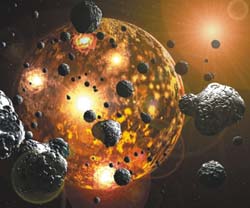Jupiter: Friend or Foe?

On Friday 24th August at the European Planetary Science Congress in Potsdam, Dr Jonathan Horner will present a study of the impact hazard posed to Earth by the Centaurs, the parent population of the Jupiter Family of comets (JFCs). The results show that the presence of a Jupiter-like planet in the Solar System does not necessarily lead to a lower impact rate at the Earth.
Dr Horner, from the UK’s Open University (OU), said, “The idea that a Jupiter-like planet plays an important role in lessening the impact risk on potentially habitable planets is a common belief but there has only really been one study done on this in the past, which looked at the hazard due to the Long Period Comets. We are carrying out an ongoing series of studies of the impact risks in planetary systems, starting off by looking at our own Solar System, since we know the most about it!”
The team at the OU developed a computer model that could track the paths of 100,000 Centaurs around the Solar System over 10 million years. The simulation was run five times: once with Jupiter at its current mass, once without a Jupiter, and then with planets of three-quarters, a half and a quarter the mass of Jupiter (for comparison, Saturn is about a third of the mass of Jupiter). The team found that the impact rate in a Solar System with a planet like our Jupiter is about comparable to the case where there is no Jupiter at all. However, when the mass of Jupiter was between these two extremes, the Earth suffered an increased number of impacts from the JFCs.
Dr Horner said, “We’ve found that if a planet about the mass of Saturn or a bit larger occupied Jupiter’s place, then the number of impacts on Earth would increase. However if nothing was there at all, there wouldn’t be any difference from our current impact rate. Rather than it being a clear cut case that Jupiter acts as a shield, it seems that Jupiter almost gives with one hand and takes away with the other!”
The study shows that if there is no giant planet present, the JFCs will not be diverted onto Earth-crossing orbits, so the impact rate at the Earth is low. A Saturn-mass planet would have the gravitational pull to inject objects onto Earth-crossing orbits, but would not be massive enough to easily eject objects from the Solar System. This means that there would be more objects on Earth-crossing orbits at any given time, and therefore more impacts. However, a planet with Jupiter’s vast mass can give objects the gravitational boost to eject them from the Solar System. Therefore, if Jupiter deflects JFCs to an Earth-crossing orbit, it may well later sweep them right out of the Solar System and off the collision course with the Earth.
The group is now assessing the impact risk posed to the Earth by the Asteroids and will go on to study the Long Period Comets, before examining the role of the position of Jupiter within our system.
Media Contact
All latest news from the category: Physics and Astronomy
This area deals with the fundamental laws and building blocks of nature and how they interact, the properties and the behavior of matter, and research into space and time and their structures.
innovations-report provides in-depth reports and articles on subjects such as astrophysics, laser technologies, nuclear, quantum, particle and solid-state physics, nanotechnologies, planetary research and findings (Mars, Venus) and developments related to the Hubble Telescope.
Newest articles

Combatting disruptive ‘noise’ in quantum communication
In a significant milestone for quantum communication technology, an experiment has demonstrated how networks can be leveraged to combat disruptive ‘noise’ in quantum communications. The international effort led by researchers…

Stretchable quantum dot display
Intrinsically stretchable quantum dot-based light-emitting diodes achieved record-breaking performance. A team of South Korean scientists led by Professor KIM Dae-Hyeong of the Center for Nanoparticle Research within the Institute for…

Internet can achieve quantum speed with light saved as sound
Researchers at the University of Copenhagen’s Niels Bohr Institute have developed a new way to create quantum memory: A small drum can store data sent with light in its sonic…





















